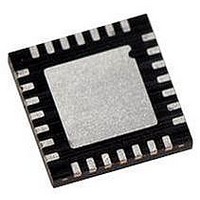PIC18F26K22-I/ML Microchip Technology, PIC18F26K22-I/ML Datasheet - Page 272

PIC18F26K22-I/ML
Manufacturer Part Number
PIC18F26K22-I/ML
Description
IC PIC MCU 64KB FLASH 28QFN
Manufacturer
Microchip Technology
Series
PIC® XLP™ 18Fr
Datasheets
1.PIC16F722-ISS.pdf
(8 pages)
2.PIC18F26J13-ISS.pdf
(496 pages)
3.PIC18F24K22-ISP.pdf
(494 pages)
Specifications of PIC18F26K22-I/ML
Core Size
8-Bit
Program Memory Size
64KB (32K x 16)
Core Processor
PIC
Speed
64MHz
Connectivity
I²C, SPI, UART/USART
Peripherals
Brown-out Detect/Reset, HLVD, POR, PWM, WDT
Number Of I /o
24
Program Memory Type
FLASH
Eeprom Size
1K x 8
Ram Size
3.8K x 8
Voltage - Supply (vcc/vdd)
1.8 V ~ 5.5 V
Data Converters
A/D 19x10b
Oscillator Type
Internal
Operating Temperature
-40°C ~ 85°C
Package / Case
28-VQFN Exposed Pad
Controller Family/series
PIC18
No. Of I/o's
25
Eeprom Memory Size
1KB
Ram Memory Size
3896Byte
Cpu Speed
64MHz
No. Of Timers
7
Lead Free Status / RoHS Status
Lead free / RoHS Compliant
Available stocks
Company
Part Number
Manufacturer
Quantity
Price
Company:
Part Number:
PIC18F26K22-I/ML
Manufacturer:
MICROCHIP
Quantity:
3 400
Part Number:
PIC18F26K22-I/ML
Manufacturer:
MICROCHIP/微芯
Quantity:
20 000
- Current page: 272 of 494
- Download datasheet (6Mb)
PIC18(L)F2X/4XK22
16.1.2.9
1.
2.
3.
4.
5.
6.
7.
8.
9.
10. Get the received 8 Least Significant data bits
11. If an overrun occurred, clear the OERR flag by
DS41412A-page 272
Initialize the SPBRGHx:SPBRGx register pair
and the BRGH and BRG16 bits to achieve the
desired baud rate (see Section 16.3 “EUSART
Baud Rate Generator (BRG)”).
Set the RXx/DTx and TXx/CKx TRIS controls to
‘1’.
Enable the serial port by setting the SPEN bit
and the RXx/DTx pin TRIS bit. The SYNC bit
must be clear for asynchronous operation.
If interrupts are desired, set the RCxIE interrupt
enable bit and set the GIE/GIEH and PEIE/GIEL
bits of the INTCON register.
If 9-bit reception is desired, set the RX9 bit.
Set the DTRXP if inverted receive polarity is
desired.
Enable reception by setting the CREN bit.
The RCxIF interrupt flag bit will be set when a
character is transferred from the RSR to the
receive buffer. An interrupt will be generated if
the RCxIE interrupt enable bit was also set.
Read the RCSTAx register to get the error flags
and, if 9-bit data reception is enabled, the ninth
data bit.
from the receive buffer by reading the RCREGx
register.
clearing the CREN receiver enable bit.
Asynchronous Reception Set-up:
Preliminary
16.1.2.10
This mode would typically be used in RS-485 systems.
To set up an Asynchronous Reception with Address
Detect Enable:
1.
2.
3.
4.
5.
6.
7.
8.
9.
10. Read the RCSTAx register to get the error flags.
11. Get the received 8 Least Significant data bits
12. If an overrun occurred, clear the OERR flag by
13. If the device has been addressed, clear the
Initialize the SPBRGHx, SPBRGx register pair
and the BRGH and BRG16 bits to achieve the
desired baud rate (see Section 16.3 “EUSART
Baud Rate Generator (BRG)”).
Set the RXx/DTx and TXx/CKx TRIS controls to
‘1’.
Enable the serial port by setting the SPEN bit.
The SYNC bit must be clear for asynchronous
operation.
If interrupts are desired, set the RCxIE interrupt
enable bit and set the GIE/GIEH and PEIE/GIEL
bits of the INTCON register.
Enable 9-bit reception by setting the RX9 bit.
Enable address detection by setting the ADDEN
bit.
Set the DTRXP if inverted receive polarity is
desired.
Enable reception by setting the CREN bit.
The RCxIF interrupt flag bit will be set when a
character with the ninth bit set is transferred
from the RSR to the receive buffer. An interrupt
will be generated if the RCxIE interrupt enable
bit was also set.
The ninth data bit will always be set.
from the receive buffer by reading the RCREGx
register. Software determines if this is the
device’s address.
clearing the CREN receiver enable bit.
ADDEN bit to allow all received data into the
receive buffer and generate interrupts.
9-bit Address Detection Mode Set-up
2010 Microchip Technology Inc.
Related parts for PIC18F26K22-I/ML
Image
Part Number
Description
Manufacturer
Datasheet
Request
R

Part Number:
Description:
Manufacturer:
Microchip Technology Inc.
Datasheet:

Part Number:
Description:
Manufacturer:
Microchip Technology Inc.
Datasheet:

Part Number:
Description:
Manufacturer:
Microchip Technology Inc.
Datasheet:

Part Number:
Description:
Manufacturer:
Microchip Technology Inc.
Datasheet:

Part Number:
Description:
Manufacturer:
Microchip Technology Inc.
Datasheet:

Part Number:
Description:
Manufacturer:
Microchip Technology Inc.
Datasheet:

Part Number:
Description:
Manufacturer:
Microchip Technology Inc.
Datasheet:

Part Number:
Description:
Manufacturer:
Microchip Technology Inc.
Datasheet:











